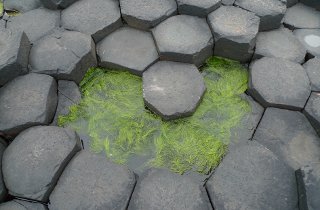The Giant's Causeway

| |
| A pool in the hexagonal pillars of the Giant's Causeway | |
The Giant's Causeway is one of those natural wonders that you read about and see carefully chosen photographs of, but which is ever so slightly disappointing in real life.
The geology is simple: a puddle of volcanic basalt began to cool and as it did so, the basalt - naturally - shrank. Basalt, however, is heavy stuff, so instead of contracting around the edges, the liquid shrank into "cells" about 15" across and, because of the crystalline nature of basalt, the cells tended to have straight sides and usually six of them. The result: columns of basalt with between four and eight sides and split into "biscuits" about a foot thick.
Oh, and as the basalt split horizontally, some of the joins are convex on the bottom of one biscuit and concave on the top of the one beneath it, producing what are jocularly termed "ball and socket" joins.
There is, of course, a legend to account for this curiosity. The giant Finn McCool built it to cross to Scotland and fight another giant, but when he got there and saw the size of his opponent, he got cold feet and scampered back to Ireland with his rival in hot pursuit. His resourceful wife stuck him in a cradle and introduced him to the Scottish giant as Finn's baby. Seeing the size of the "baby", the Scot ran home in terror, so everyone lived happily ever after.
The Causeway, which is not only smaller than I had imagined, but is dwarfed by the surrounding cliffs, is managed by the National Trust. Members have free admission and free parking. There is a bus (at extra cost) to transport those unable or unwilling to walk the half mile from the Visitor Centre to the Causeway. There are two routes and we chose the shorter but more difficult one via the Shepherd's Steps. We came back via the longer but infinitely easier road!
 Causeway
Causeway